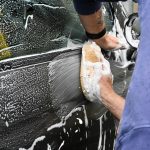How to Achieve a Showroom Shine: Pro-Level DIY Car Care Tips for Everyday Use
Dashboard and Trim Care
Dashboard and trim areas are prone to dust, fingerprints, and sunlight damage, which can cause fading and cracking over time. Start by dusting the surfaces with a microfiber cloth to capture fine particles.
Use a plastic and vinyl cleaner suitable for your car’s interior to remove any embedded dirt or grime. Apply the cleaner to a cloth rather than directly on the surfaces to avoid overspray. Work in small areas, ensuring even coverage.
After cleaning, consider using a UV-protectant spray or lotion. These products create a barrier against UV rays, reducing the risk of fading and cracking. Regular application is key to maintaining the integrity of your dashboard and trim surfaces. This maintenance prevents long-term damage and keeps the interior looking fresh.
Enhancing Exterior Add-Ons
In achieving a showroom shine, attention to detail in wheel cleaning and maintaining headlight and trim condition is essential. Diligent care in these areas enhances the overall appearance and protects the vehicle’s components.
Wheel Cleaning and Protection
Regular cleaning helps maintain the appearance and functionality of wheels. Use a pH-balanced wheel cleaner to safely remove brake dust and road grime. A soft brush can reach tight spots without scratching the surface.
Apply a protective coating or sealant to the wheels, which can repel dirt and make future cleanings easier. It’s important to clean the wheels before washing the rest of the car to avoid splashing dirt onto a freshly cleaned surface.
Headlights and Exterior Trim Maintenance
Clear headlights enhance visibility and vehicle aesthetics. Start by cleaning headlights with a lens cleaner to remove cloudiness or oxidation. For severe cases, a restoration kit with sandpaper and polish may be necessary. Ensuring headlights are clear not only looks good but improves safety.
For exterior trim, a trim conditioner or restorer can bring back the original color and shine. This is particularly useful for plastic and rubber components that can fade over time. Regular application helps protect these parts from UV damage and environmental elements, maintaining a polished look.
Assessing the Results
After applying car care treatments, it’s essential to evaluate how well they perform over time and under various conditions. This includes checking the durability of the treatment and examining how well it protects the car’s surface.
Durability and Longevity of Treatment
Assessing the durability of a car care treatment involves regular inspections. Over time, look for signs of wear, such as fading or loss of gloss. Pay attention to how long the treatment maintains its protective qualities, especially against environmental factors like UV rays, dirt, and grime.
Catch early signs that indicate the need for reapplication. By monitoring the longevity of the treatment, owners can schedule maintenance in a timely manner to ensure continuous protection and showroom shine.
Water Beading and Protection Tests
Another effective way to evaluate a treatment’s effectiveness is to perform water beading tests. After washing the car, splash water on its surface and observe how the droplets behave. Tightly formed beads indicate a strong protective layer, while water spreading out suggests diminished protection.
Water beading is an immediate visual cue of how well the treatment is holding up. It provides insight into the car’s surface condition and the necessity for reapplication, if required, to maintain optimal protection.



